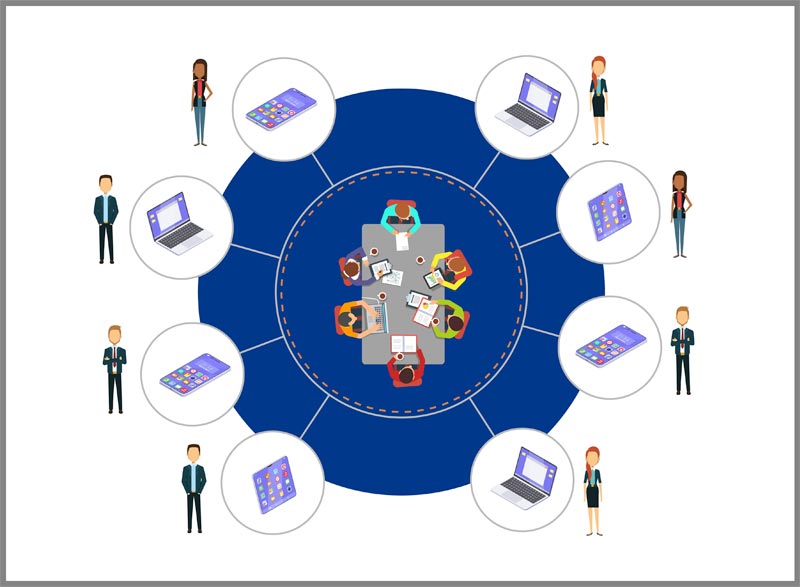This article is a quick snapshot of how to re-use virtual event videos produced in your post-event marketing efforts. Take me to the template.
Today virtual events are experiencing a corona virus-related boom. It’s accessibility, flexibility, a time-saving benefit for the audience, cost-effectiveness, and most important of all – the social distancing compliance element of it all, is making them the new marketing normal! The very obvious channel of presenting a virtual event is through live streaming or on-demand video through the various tools/resources available today. What’s a less known fact is that videos created at these virtual events have great content that can also be rehashed and used again as an intriguing video asset to continue the conversation with your clients, prospects, or even new logos! While ‘video marketing’ is a trend that is considered essential to the marketing mix, effective re-application of the videos has been an effort that’s yet to be deployed effectively. So, how do we go about it?
The typical challenges that we commonly hear are;
1. Is there any content that was produced during the event which can be used again?
2. We are out of assets. It was all used during the event… Now we need more for post-event promotions
3. Can we create some snackable assets from the content used at the event?
Below is a 6 step process on how this can be done.
STEP 1: AVOID THE PLAN THAT STARTS 2 WEEKS BEFORE THE EVENT
Start well-in-advance. Based on the event agenda, understand the kind of videos that can be captured. Make a listicle of type of videos. A sample set of videos could be:
1. Testimonial videos
2. 2-way interview videos
3. Break out room session videos
4. Recap videos (quick recap of the event with or without a moderator talking into the camera), otherwise called Sizzle Reel videos
While we understand that filming and editing such videos well-in-advance could be an uphill battle, there are easier ways around it. Take a look.!
STEP 2: BE CLEAR ON THE FORMAT OF THE VIDEOS
A) Pen down the description of each of the video types so that we (advertiser/marketer) and our clients are on the same page as to what each one of them means. Some examples:
Demo Video – Product/offering/service showcase video
Recap Videos – Host talking into the camera on the recap or it could be:
a. Host and a prominent speaker/guest together summarizing the video
b. Collage of snapshots from the event – with a VO (will need to be edited)
B) Be clear on the length of the video. This will be important while planning the usage of the same.
STEP 3: PIN DOWN THE AUDIENCE ITS MEANT FOR
It’s important to be clear on the audience it’s meant for. This will help further plan out the possible channels we will use it in, to reach a specific audience. It may also impact the format of the video.
For example:
Demo Videos – IT Architects, Developers, Data Scientists
STEP 4: SLOT THE STAGE OF THE JOURNEY WHERE THE VIDEO FITS INTO
Split the videos into the different stages of the customer journey. Basically slotting it into stages of the journey where you believe the content would work best. It could go right across from Discover, Early Learn, Late Learn, Try, Buy and so on…
For example:
Fireside chat video – where a moderator having a discussion with an expert / Senior leader could be something used in the Discover or Early Learn stage.
STEP 5: DECIDE THE INTENT
Now it’s time to decide the ‘intent’ that can be met with the video. Basically, what is the intended action expected from the audience you are targeting when they see this video? Answering this question will also drive a stronger orientation of the content planned for the same.
For example:
A Demo – could be used to encourage a trial
STEP 6: DECIDING THE MARKETING CONDUIT
Last, but not least, we are to decide which channels would work best for the video we intent to produce.
For example:
POV video on existing trends of technology – could be used in:

Some pre-requisites are essential during this process:
1. Sign off on the ‘video chart (see template)’ planned from client
2. Sign off on the plan for future use of the video from the client (which is part of the template)
3. Assignment of spocs from the client’s end to aid – in video usage post-event56t
a. Get talent/rights forms signed off- so that they can be used across channels
4. Detailed list at least a week before the event – of possible clients who would be attending the virtual event and whom we intend to have audience/video interviews.
a. Get the questions in place for the interviews with approvals from the client’s internal marketing teams and if required client’s client and legal teams
b. Get as many of videos pre-recorded
5. Specify the need for a distinguished moderator during the interview if required
6. Sign off on editing time (If required for uploads in real-time).
7. Buying and testing with tools to make the videos interactive
8. Good audio equipment in place for effective audio/videos recordings to be done
9. Sign off on budgets for appropriate PO releases to be done
While shifting lead gen from traditional to digital, why don’t you take a look at how Position2 can you put your marketing to work.